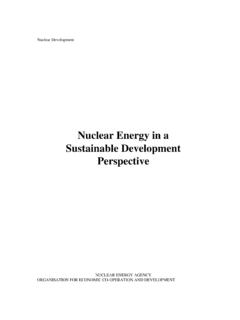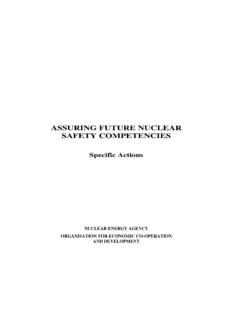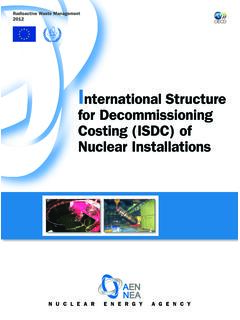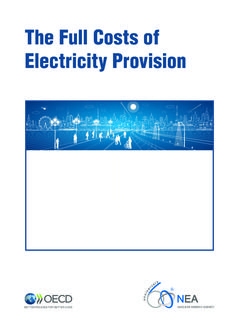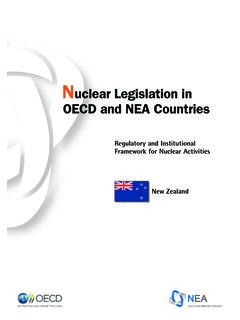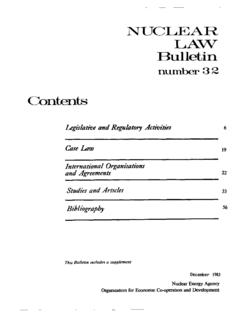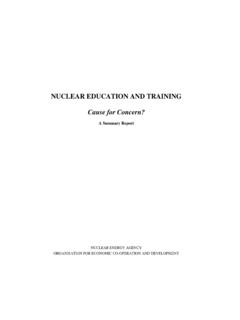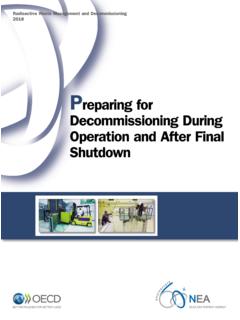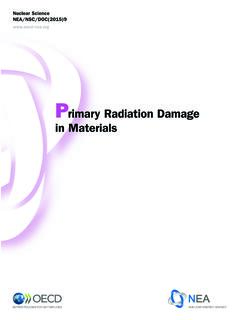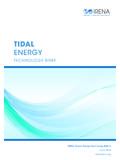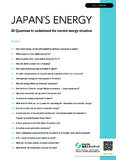Transcription of Projected Costs of Generating Electricity 2015 Edition
1 Projected Costs of Generating Electricity 2015 Edition Projected Costs of Generating Electricity 2015 Edition INTERNATIONAL ENERGY AGENCY. NUCLEAR ENERGY AGENCY. ORGANISATION FOR ECONOMIC CO-OPERATION AND DEVELOPMENT. INTERNATIONAL ENERGY AGENCY. The International Energy Agency (IEA), an autonomous agency, was established in November 1974. Its primary mandate was and is two-fold: to promote energy security amongst its member countries through collective response to physical disruptions in oil supply, and provide authoritative research and analysis on ways to ensure reliable, affordable and clean energy for its 29 member countries and beyond.
2 The IEA carries out a comprehensive programme of energy co-operation among its member countries, each of which is obliged to hold oil stocks equivalent to 90 days of its net imports. The Agency's aims include the following objectives: Secure member countries' access to reliable and ample supplies of all forms of energy; in particular, through maintaining effective emergency response capabilities in case of oil supply disruptions. Promote sustainable energy policies that spur economic growth and environmental protection in a global context particularly in terms of reducing greenhouse-gas emissions that contribute to climate change.
3 Improve transparency of international markets through collection and analysis of energy data. Support global collaboration on energy technology to secure future energy supplies and mitigate their environmental impact, including through improved energy efficiency and development and deployment of low-carbon technologies. Find solutions to global energy challenges through engagement and dialogue with non-member countries, industry, international organisations and other stakeholders. NUCLEAR ENERGY AGENCY. The OECD Nuclear Energy Agency (NEA) was established on 1 February 1958. Current NEA membership consists of 31 countries: Australia, Austria, Belgium, Canada, the Czech Republic, Denmark, Finland, France, Germany, Greece, Hungary, Iceland, Ireland, Italy, Japan, Korea, Luxembourg, Mexico, the Netherlands, Norway, Poland, Portugal, Russia, the Slovak Republic, Slovenia, Spain, Sweden, Switzerland, Turkey, the United Kingdom and the United States.
4 The European Commission also takes part in the work of the Agency. The mission of the NEA is: to assist its member countries in maintaining and further developing, through international co-operation, the scientific, technological and legal bases required for a safe, environmentally friendly and economical use of nuclear energy for peaceful purposes;. to provide authoritative assessments and to forge common understandings on key issues, as input to government decisions on nuclear energy policy and to broader OECD policy analyses in areas such as energy and sustainable development. Specific areas of competence of the NEA include the safety and regulation of nuclear activities, radioactive waste management, radiological protection, nuclear science, economic and technical analyses of the nuclear fuel cycle, nuclear law and liability, and public information.
5 The NEA Data Bank provides nuclear data and computer program services for participating countries. In these and related tasks, the NEA works in close collaboration with the International Atomic Energy Agency in Vienna, with which it has a Co-operation Agreement, as well as with other international organisations in the nuclear field. ORGANISATION FOR ECONOMIC CO-OPERATION AND DEVELOPMENT. The OECD is a unique forum where the governments of 34 democracies work together to address the economic, social and environmental challenges of globalisation. The OECD is also at the forefront of efforts to understand and to help governments respond to new developments and concerns, such as corporate governance, the information economy and the challenges of an ageing population.
6 The Organisation provides a setting where governments can compare policy experiences, seek answers to common problems, identify good practice and work to co-ordinate domestic and international policies. The OECD member countries are: Australia, Austria, Belgium, Canada, Chile, the Czech Republic, Denmark, Estonia, Finland, France, Germany, Greece, Hungary, Iceland, Ireland, Israel, Italy, Japan, Korea, Luxembourg, Mexico, the Netherlands, New Zealand, Norway, Poland, Portugal, the Slovak Republic, Slovenia, Spain, Sweden, Switzerland, Turkey, the United Kingdom and the United States. The European Commission takes part in the work of the OECD.
7 OECD Publishing disseminates widely the results of the Organisation's statistics gathering and research on economic, social and environmental issues, as well as the conventions, guidelines and standards agreed by its members. Copyright 2015. (30 September 2015 version). Organisation for Economic Co-operation and Development/International Energy Agency 9, rue de la F d ration, 75739 Paris Cedex 15, France and Organisation for Economic Co-operation and Development/Nuclear Energy Agency 12, boulevard des les, 92130 Issy-les-Moulineaux, France Please note that this publication is subject to specific restrictions that limit its use and distribution.
8 The terms and conditions are available online at Foreword Electricity is the fastest-growing final form of energy, and yet despite its increasing relevance to decarbonisation efforts, the future composition of the power sector remains uncertain. As policy makers work to ensure that the power sector is reliable and affordable, while making it increasingly clean and sustainable, it is ever more crucial that they understand what determines the relative cost of Electricity generation using fossil fuel, nuclear or renewable technologies. This eighth Edition of Projected Costs of Generating Electricity , which examines in depth the levelised Costs of Electricity (LCOE) generation for all main Electricity Generating technologies, reveals a number of interesting findings that have implications for policy makers.
9 Drawing on a database that includes a greater variety of technologies and a larger number of countries than previous editions, this report reaffirms many of the insights and lessons of the prior editions. The drivers of the cost of different Generating technologies remain both market- and technology-specific. Low-carbon technologies remain highly capital intensive, and their overall cost depends significantly on the cost of capital. The relative cost of coal and natural gas-fired generation, meanwhile, is heavily contingent on fuel Costs and, should such policies be fully implemented, the price of CO2 emissions. One key trend that emerges is the significant decline in recent years in the cost of renewable generation as a result of the use of improved technologies and continued governmental support.
10 The report also reveals that nuclear energy Costs remain in line with the cost of other baseload technologies, despite persistent reports to the contrary. No single technology, however, can be said to be the cheapest under all circumstances. Rather, market structure, the policy environment and resource endowments all play a strong role in determining the final levelised cost of any given investment. This study focuses on the LCOE metric because it remains valuable to policy makers for its relative simplicity and the ease with which it allows for comparability. Nevertheless, the relevance of LCOE in a world with liberalised power markets and increasing penetrations of variable renewable generation has been called into question.
